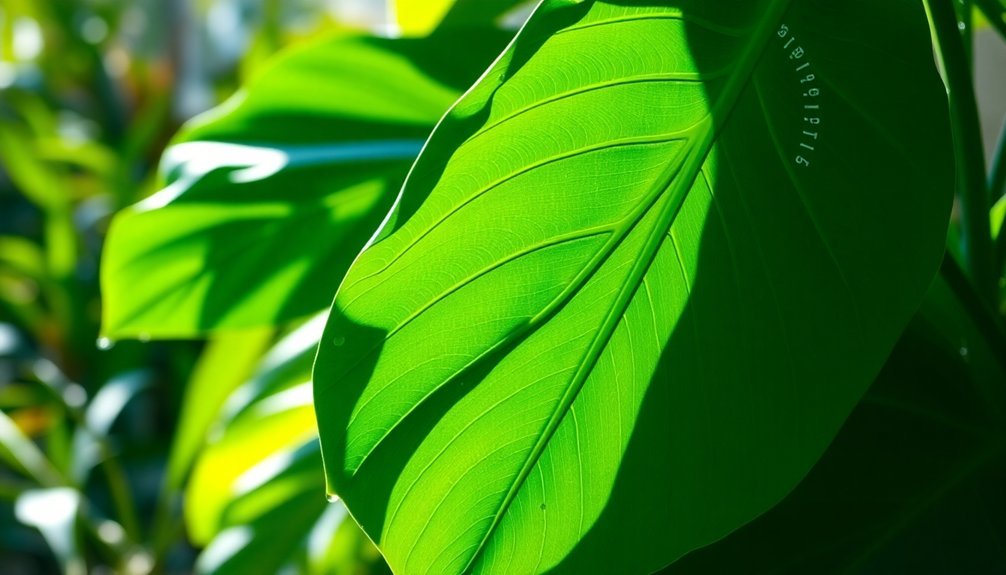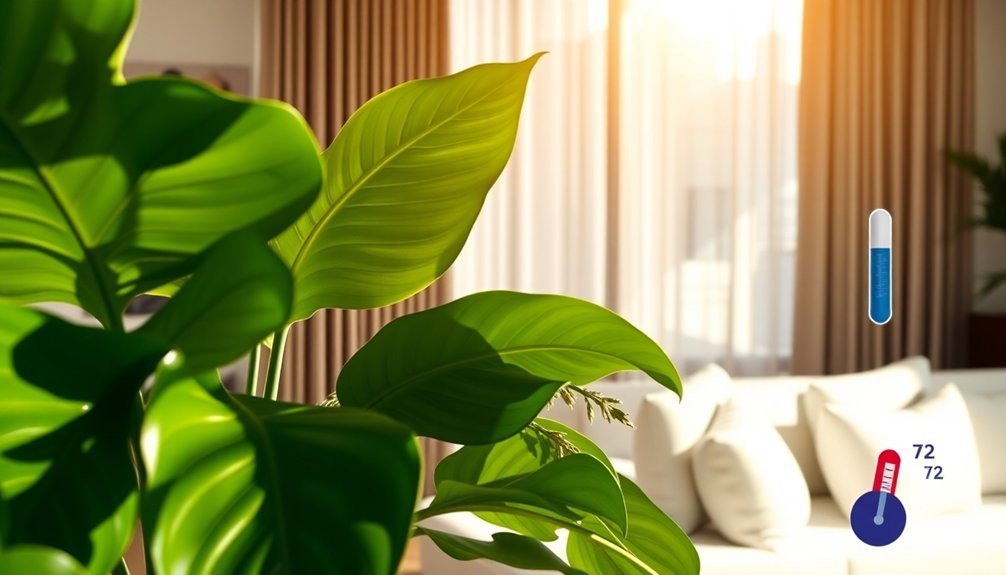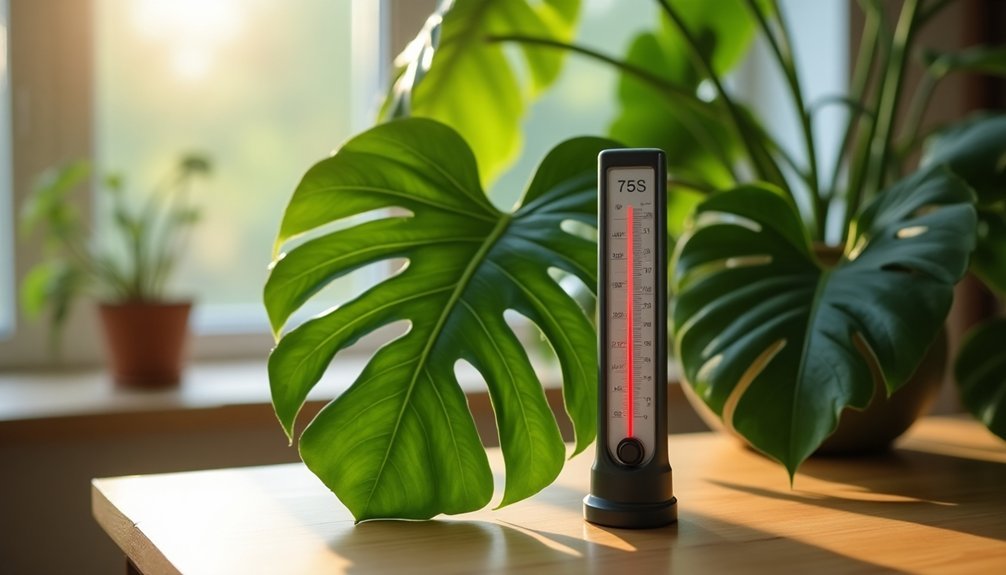Your Monstera thrives in 65-85°F temperatures because these conditions mirror its tropical rainforest origins in Central America. This temperature sweet spot supports ideal photosynthesis, nutrient absorption, and steady growth while promoting healthy root development and proper leaf fenestration. When you maintain these warm, stable conditions, you'll boost your plant's metabolism and prevent stress-related issues. Understanding how temperature affects your Monstera's growth can transform it from surviving to flourishing.
The Natural Habitat Connection

While Monstera plants have become popular houseplants worldwide, their temperature preferences stem directly from their tropical rainforest origins in Central America.
As tropical natives, Monsteras bring a piece of Central American rainforest into our homes through their distinct temperature needs.
You'll find that these plants thrive best in stable temperatures between 65-85°F, mirroring the consistent warmth they experience beneath the forest canopy.
This ideal range isn't just about comfort – it's crucial for your Monstera's healthy growing patterns. When you maintain tropical-like temperatures, you're helping your plant efficiently absorb nutrients and carry out essential processes like photosynthesis.
Your Monstera's natural adaptations mean it can handle minor temperature fluctuations, but exposing it to conditions outside this range can lead to temperature stress.
Understanding Temperature Ranges
Although Monsteras can tolerate brief temperature fluctuations, they perform best within a specific sweet spot of 65-85°F (18-29°C). You'll notice your Monstera plants thrive when you maintain these ideal temperature ranges, as they support essential growth processes and prevent plant shock.
| Temperature | Plant Response |
|---|---|
| Below 65°F | Slowed growth, stress symptoms |
| 65-75°F | Steady, healthy growth |
| 75-85°F | Peak metabolic activity |
| Above 85°F | Risk of water loss, needs more humidity |
When you keep your Monstera within these temperature ranges, you're recreating their natural tropical environment. This consistency promotes proper nutrient absorption and helps develop those distinctive leaf fenestrations you're looking for. Watch for signs like yellowing leaves or wilting, as they indicate you've strayed from the ideal temperature zone.
Growth Rate and Temperature Link

Temperature plays a direct role in your Monstera's growth speed and vigor. When you maintain ideal temperatures between 65-85°F, you'll notice your plant thriving at its peak growth rate. The warmth enhances your Monstera's ability to process nutrients and develop those stunning fenestrated leaves.
Here's how temperature impacts your Monstera's development:
- Warmer temperatures boost photosynthesis efficiency, leading to faster leaf production.
- Consistent warmth guarantees steady metabolic processes for better nutrient absorption.
- Maintaining prime temperature prevents stress-induced growth delays.
- Temperatures below 60°F can force your plant into unwanted dormancy.
Temperature Effects on Leaf Development
Your Monstera's leaf development relies heavily on maintaining temperatures between 65°F and 85°F (18°C to 29°C), which directly impacts how quickly and effectively cells divide to form those iconic splits and holes.
You'll notice that fenestrations develop more consistently and prominently when your plant experiences stable temperatures within this preferred range, as the warm conditions support efficient cellular growth.
At these ideal temperatures, your Monstera's new leaves will unfurl faster and develop more pronounced fenestrations compared to plants kept in cooler conditions.
Fenestration Growth Patterns
When growing a Monstera, understanding how temperature affects its iconic leaf fenestrations is essential for achieving those sought-after splits and holes.
You'll find that maintaining temperatures between 65-85°F creates the perfect environment for ideal fenestration development and growth.
Here's how temperature impacts your Monstera's fenestration patterns:
- Temperatures below 65°F will slow your plant's growth and reduce fenestration formation.
- Maintaining warmth between 65-85°F promotes healthy cell division and leaf development.
- Consistent ideal temperatures enhance photosynthesis and nutrient absorption.
- Temperatures above 85°F can cause stress, leading to leaf curling and reduced fenestration quality.
Leaf Cell Division Rates
Building on how temperature affects fenestration patterns, let's examine the cellular processes that drive your Monstera's leaf development.
Your Monstera's leaf cell division rates thrive between 65-85°F, where they'll produce the healthiest and most vigorous growth. When you maintain temperatures within this optimal range, you're supporting efficient photosynthesis and nutrient uptake, which are essential for robust leaf growth.
If your plant experiences temperatures below 65°F, you'll notice stunted growth as cell division slows dramatically. Similarly, temperatures exceeding 85°F can stress your plant, causing cellular damage and compromising leaf health.
The key to maintaining healthy leaf development lies in temperature stability – fluctuations outside the ideal range can disrupt your plant's hormonal balance, affecting the structural integrity of new leaves.
Root Health at Different Temperatures

Your Monstera's roots perform best between 65°F and 85°F, where they actively absorb nutrients and maintain healthy growth patterns.
When temperatures climb above 85°F, you'll need to monitor moisture levels more closely as the roots can dry out faster and become stressed.
If you let temperatures drop below 65°F, your plant's root system will slow down considerably, and prolonged exposure to temperatures under 50°F can permanently damage the roots and invite devastating problems like root rot.
Root Growth Above 85°F
Temperature levels exceeding 85°F (29°C) can greatly compromise your Monstera's root health and overall growth patterns.
When your plant faces high soil temperatures, you'll notice several concerning changes in its development and wellbeing.
Here's what happens to your Monstera's roots above 85°F:
- Root growth becomes stunted due to increased evaporation, making it harder for your plant to maintain proper hydration.
- The beneficial microbial ecosystem in the soil deteriorates, reducing your plant's nutrient absorption capabilities.
- Roots become less efficient at taking up water, leading to visible wilting and drooping leaves.
- Your Monstera faces an increased risk of root rot as the roots turn dark and mushy, struggling to regulate water uptake effectively.
These conditions can create lasting damage if not addressed promptly through temperature management.
Optimal Root Zone 65-85°F
To maintain robust growth and development, Monstera roots thrive within a specific temperature range of 65-85°F (18-29°C). This ideal root zone temperature creates the perfect environment for healthy root development and efficient nutrient absorption.
You'll notice your Monstera struggling if temperatures fall below 65°F, as the cold soil leads to stunted growth and poor nutrient uptake. Similarly, when temperatures exceed 85°F, your plant's roots become stressed and susceptible to root rot. The key is maintaining stability within this sweet spot.
To help your Monstera maintain optimal root temperatures, use well-draining potting mixes and consider insulating the soil. This protection becomes especially important during seasonal changes when ambient temperatures fluctuate.
Cold Damage Below 65°F
When Monstera roots experience temperatures below 65°F, they begin showing clear signs of distress through wilting leaves and yellowing foliage.
Your plant's root health considerably deteriorates when exposed to temperatures outside its preferred range, making it essential to maintain warmth and protect it from cold drafts.
You'll notice these warning signs of cold stress when your Monstera's experiencing temperatures below 65°F:
- Wilting leaves with blackened edges
- Reduced nutrient absorption and stunted growth
- Yellowing foliage indicating compromised root health
- Dark brown spots on leaves in severe cases
If temperatures drop below 50°F, your plant faces severe cold damage that can be fatal.
To prevent this, you'll want to consistently maintain temperatures between 65-85°F, ensuring your Monstera's roots stay healthy and active.
Signs of Temperature Stress

Just like humans, Monsteras display clear signs of distress when exposed to temperatures outside their comfort zone. When stressed by cold conditions below 65°F, you'll notice wilting leaves and yellowing foliage. The edges of leaves may turn black, especially if your plant is exposed to drafts.
Your Monstera might also drop leaves as a response to temperature discomfort.
At the other extreme, when temperatures climb above 85°F, you'll spot curled leaves with brown, crispy patches forming on the surface. Without proper humidity, these signs become more pronounced.
Watch for any sudden changes in your plant's appearance, as fluctuating temperatures can cause leaf stretching and slower growth. Regular temperature monitoring helps you catch these warning signs early and adjust your plant's environment accordingly.
Seasonal Temperature Adjustments
Successfully maintaining your Monstera throughout the year requires thoughtful seasonal temperature adjustments that mirror its tropical habitat.
To prevent stress and avoid shocking your plant, you'll need to keep in mind the natural temperature fluctuations that occur as seasons change.
Follow these essential guidelines to maintain ideal conditions:
- Monitor nighttime temperatures during winter, ensuring they don't drop below 60°F.
- Relocate your plant away from drafty windows and heating vents to find perfect spots.
- Increase humidity levels during warmer months to combat moisture loss.
- Make gradual temperature adjustments rather than sudden changes.
Remember that your Monstera thrives best between 65°F and 85°F.
Temperature and Watering Balance

You'll need to adjust your Monstera's watering schedule as temperatures fluctuate, providing more water during warmer periods when moisture evaporates quickly and less during cooler times when the plant's uptake slows down.
When watering your Monstera, use room temperature water rather than cold water, as cold water can shock the root system and disrupt nutrient absorption.
During seasonal shifts, it's essential to check the top inch of soil before watering, as temperature changes directly impact how quickly your plant uses water.
Moisture Needs By Temperature
While Monstera plants are generally adaptable, understanding the relationship between temperature and watering needs is crucial for their health. Your plant's moisture requirements will vary greatly based on temperature conditions, with the best range being 65°F to 85°F for proper water uptake and root function.
To maintain healthy moisture levels at different temperatures:
- Keep temperatures between 65°F to 85°F to guarantee optimal water absorption and prevent common issues like yellowing leaves.
- Watch for slower water uptake below 65°F, which can lead to overwatering and potential root problems.
- Increase watering frequency when temperatures exceed 85°F to combat increased evaporation.
- Monitor soil moisture more closely during temperature fluctuations, adjusting your watering schedule accordingly.
Remember that consistent temperatures within the ideal range will help maintain proper humidity and support your Monstera's overall health.
Cold Water vs. Warm
The temperature of water used for Monstera plants plays a vital role in their growth and health. When you use cold water, you'll risk shocking your plant's root system, disrupting nutrient uptake and potentially causing wilting or yellowing leaves. This is particularly problematic if your plant is already experiencing temperature fluctuations in its environment.
Instead, opt for warm water at room temperature to support your Monstera's thriving growth. Warm water helps maintain ideal soil temperature, ensuring roots stay active and efficiently absorb nutrients.
If you're using tap water, let it sit for a few hours before watering your plant. This simple step allows the water to reach an appropriate temperature and supports your Monstera's metabolic processes, leading to healthier growth and development.
Seasonal Watering Shifts
Understanding how temperature affects your Monstera's water needs goes beyond just water temperature. Your plant requires consistent watering that adapts to seasonal temperature shifts to maintain healthy foliage.
Follow these essential guidelines for ideal moisture balance:
- Increase your watering frequency during spring and summer when temperatures reach 65-85°F (18-29°C), as warm soil dries faster.
- Reduce watering in fall and winter when cooler temperatures cause soil to retain moisture longer, preventing root rot.
- Check soil moisture with your finger before each watering session to avoid overhydration.
- Adjust your watering routine based on temperature changes, watching for signs of stress like yellowing or wilting leaves.
This temperature-conscious approach guarantees your Monstera thrives through every seasonal change while maintaining proper hydration.
Humidity Requirements by Temperature

Maintaining proper humidity levels for your Monstera directly correlates with the ambient temperature in your growing space.
You'll want to keep humidity at 50% or higher for your plant to thrive throughout the ideal temperature range of 65-85°F.
When your growing area reaches temperatures above 80°F, your Monstera needs extra humidity to compensate for increased evaporation from its leaves.
At lower temperatures around 65°F, consistent humidity helps guarantee healthy leaf development and prevents growth issues.
If you're maintaining warmer conditions, watch for signs like curling leaves or brown tips, which indicate insufficient moisture in the air.
The key is matching humidity to temperature – higher temps require higher humidity levels to support robust photosynthesis and keep your Monstera's metabolic processes running smoothly.
Heat Sources and Plant Placement
Since Monsteras are sensitive to their environment, proper placement relative to heat sources plays an essential role in their health.
To maintain the ideal 65°F to 85°F range and prevent temperature-related stress, you'll need to carefully consider your plant's location.
For best growth, follow these placement guidelines:
- Position your Monstera in bright indirect sunlight, which helps maintain consistent ambient temperature while protecting leaves from burn.
- Keep your plant away from drafty windows and heating vents that can cause sudden temperature fluctuations.
- Use a space heater during cold months to maintain warmth, especially if your home runs cool.
- Monitor room temperature regularly with a thermometer, relocating your plant to warmer areas if needed.
These strategic placement decisions will help your Monstera thrive in its preferred temperature range.
Cold Draft Prevention Strategies

While Monsteras can adapt to various indoor conditions, protecting them from cold drafts remains crucial for their survival and growth.
To minimize exposure to cold, keep your Monstera away from windows and doors where chilly air can seep in, particularly at night when temperatures drop considerably.
You'll want to add proper insulation around the pot using materials like burlap or bubble wrap during winter months.
Consider using thermal curtains on windows to regulate room temperature and reduce drafts.
Elevate your plant using stands or shelves to prevent contact with cold floors that could affect soil temperature.
Remember to monitor indoor temperatures regularly with a thermometer, ensuring they stay between 65°F and 85°F.
Making these adjustments will help create a stable environment where your Monstera can thrive.
Temperature Monitoring Methods
To effectively care for your Monstera, implementing reliable temperature monitoring methods proves essential for its long-term health.
You'll need to track both ambient temperature and soil conditions to maintain the ideal range of 65-85°F.
Key monitoring strategies include:
Effective monitoring techniques are essential for maintaining optimal growing conditions and ensuring your Monstera plant thrives year-round.
- Using a digital thermometer to measure ambient temperature around your plant, ensuring favorable growing conditions.
- Installing a smart thermostat that provides real-time alerts and temperature tracking capabilities.
- Checking soil temperature with a soil thermometer, as roots need protection from temperatures below 50°F.
- Keeping a temperature log to document changes and identify patterns.
Watch for cold drafts near windows or heat sources that could disrupt your plant's environment.
Emergency Temperature Solutions

Even the most diligent plant parents may encounter unexpected temperature challenges with their Monstera. When faced with temperature fluctuations outside the ideal temperature range of 65-85°F, you'll need quick emergency solutions to protect your plant.
| Temperature Issue | Emergency Solution |
|---|---|
| Below 60°F nights | Cover with light sheet |
| Cold drafts | Wrap pot in insulating material |
| Excessive heat | Relocate to cooler room |
| Air circulation needs | Use fans indirectly |
| Temperature tracking | Install thermometer |
Monitor the plant closely for signs of stress, including wilting or yellowing leaves. To protect root health during sudden cold snaps, wrap the pot in insulating material to maintain soil temperature. You can also use a thermometer to track temperature changes, allowing you to make swift adjustments when conditions become unfavorable for your Monstera.
Frequently Asked Questions
What Temperature Is Too Hot for Monstera?
Your monstera will struggle when temperatures exceed 85°F (29°C). It's especially critical to avoid exposure above 90°F (32°C), as you'll notice heat stress symptoms like wilting, brown patches, and leaf curling.
Do Monsteras Like It Hot?
While your Monstera can handle warm conditions, it doesn't love extreme heat. You'll see the best growth between 65-85°F. If it's hotter, you'll need to increase humidity to prevent stress and damage.
What Climate Does Monstera Like?
Your Monstera will thrive in warm, tropical conditions where temperatures stay between 65-85°F. You'll want to maintain high humidity and protect it from cold drafts to mimic its natural rainforest habitat.
Should Monstera Go Outside in Summer?
Yes, you can place your Monstera outside during summer if temperatures stay between 65-85°F. Just remember to acclimate it gradually, provide partial shade, and bring it inside when nights get cooler than 60°F.
In Summary
Your Monstera's love for 65-85°F temperatures directly mirrors its tropical origins. When you maintain this sweet spot, you're recreating the plant's natural habitat, promoting ideal photosynthesis and healthy growth cycles. Remember, fluctuations outside this range can stress your plant and slow its development. Stay vigilant with temperature monitoring, keep it away from drafts, and you'll be rewarded with a thriving, happy Monstera.





Leave a Reply